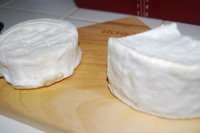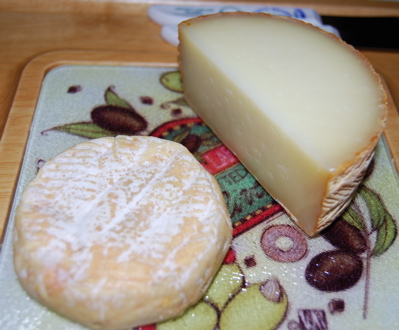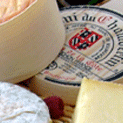Cheese and Wine
Pairing and Serving
 When cheese and wine pairing, making sure your cheese is presented in the ideal conditions is critical to the full appreciation of each cheese. We assume you already know something about how to serve wine. If not, see our How to Serve Wine section for a primer. Serving cheese is not as complicated but there are a few secrets to making the cheese most presentable and most delicious!
When cheese and wine pairing, making sure your cheese is presented in the ideal conditions is critical to the full appreciation of each cheese. We assume you already know something about how to serve wine. If not, see our How to Serve Wine section for a primer. Serving cheese is not as complicated but there are a few secrets to making the cheese most presentable and most delicious!

Cheese Serving Temperature
One of the most important aspects to serving cheese and also one of the most commonly overlooked is temperature. When cheese and wine pairing, your cheese will not show its best if served at the wrong temperature. Most of us who do not have a cheese cave to store our cheese, store it after purchase in our refrigerator. This is fine for the short-term storage of most cheeses and even the longer-term storage of very hard, aged cheeses. However, refrigerator temperature is quite a bit below the ideal cheese service temperature. Many people, and restaurants, make the mistake of serving cheese straight out of the refrigerator. At these low temperatures, cheeses have a harder texture which is not as caressing and creamy. Also, their flavors and aromas are muted, laking the depth and complexity they can have. As they warm up they get softer, fuller and more lush. Most cheeses show best when close to room temperature. Unless it is very hot in your house, we like recommend removing the cheese from the refrigerator at least 30 to 60 minutes before service, letting it sit and slowly warm up at room temperature. Next time you buy good cheese, try this out...immediately taste a cheese straight from the refrigerator. Then leave the same cheese to rest at room temperature for an hour. Come back and taste and again. You may be surprised how much it changes!
Cheese Platters
Presentation is always nice so pay attention to how you plate your cheeses. You can really use any type of platter or plate to serve cheese, but traditionally a cheese board is a wooden or even stone (such as marble or soap-stone) board or slab. Gently unwrap your cheeses and place them gently on your service platter without disrupting their normal shape and appearance. Very soft cheeses sometimes come in a wood box or basket and can be served right in the box, using a small spoon to scoop the cheese out for service. Ideally, if several cheeses are presented at once on a platter, try to arrange them roughly in order of intensity, starting at one side with more mild, mellow cheeses and working your way up to the more intense, stinky and powerful flavors. This gives your guest a sense of the progression to taste the cheeses in. It is also nice to introduce the cheeses so that everyone knows what they are before digging in.
Accompaniments to Cheese
While many cheeses are often eaten alone, there are several things you can do to accompany cheese when serving for a cheese and wine pairing. First of all, while hard cheeses usually only need a knife or fork to break off pieces to eat, soft, spreadable cheeses are best accompanied with sliced bread or crackers and a spreading knife. Very soft, runny cheeses are almost impossible to eat alone and really require this accompaniment to enjoy them. We usually use basic French baguettes or Batard loaves sliced thin. Additionally, many cheese platters are arranged with some other finger foods available, such as various nuts or dried fruits to accompany the cheese and wine pairing. These options are all up to you of course.

 | Fromages.com is a great website which offers dozens of the finest French cheeses right from the source. They ship perfectly ripened and stored cheeses worldwide right to your door! It is hard to find authentic French cheeses so lovingly cared for in the US, but its all available here. Their website provides descriptions and information about each cheese as well as wine pairing suggestions. You can order individual cheeses or select from their cheese boards. |
Done learning about Cheese and Wine Pairing and Serving?
Return to the Cheese and Wine page.






 When cheese and wine pairing, making sure your cheese is presented in the ideal conditions is critical to the full appreciation of each cheese. We assume you already know something about how to serve wine. If not, see our
When cheese and wine pairing, making sure your cheese is presented in the ideal conditions is critical to the full appreciation of each cheese. We assume you already know something about how to serve wine. If not, see our 




